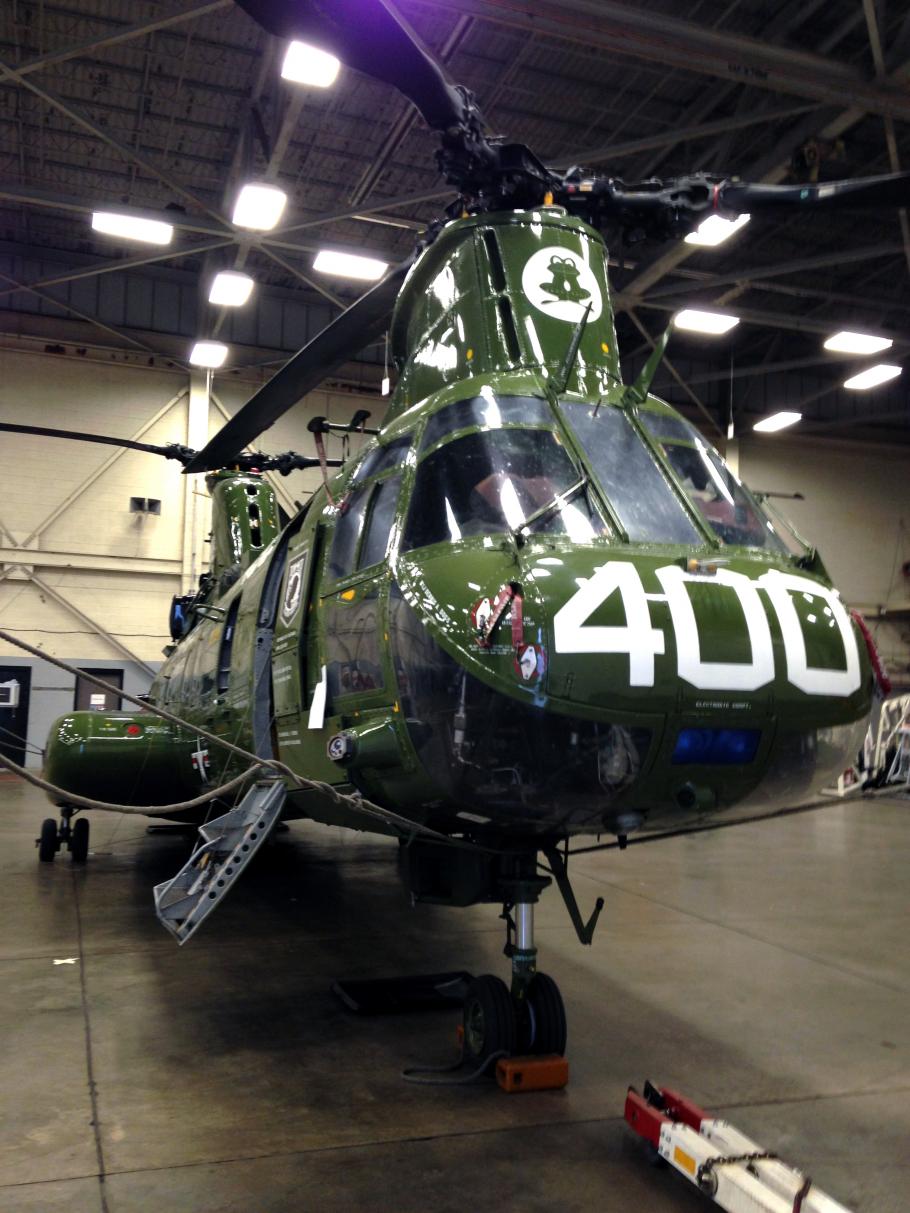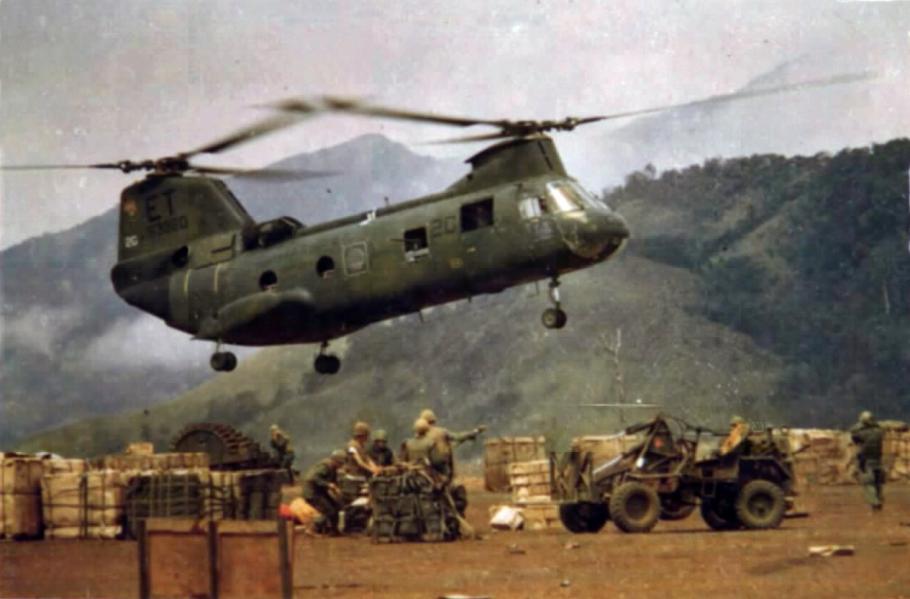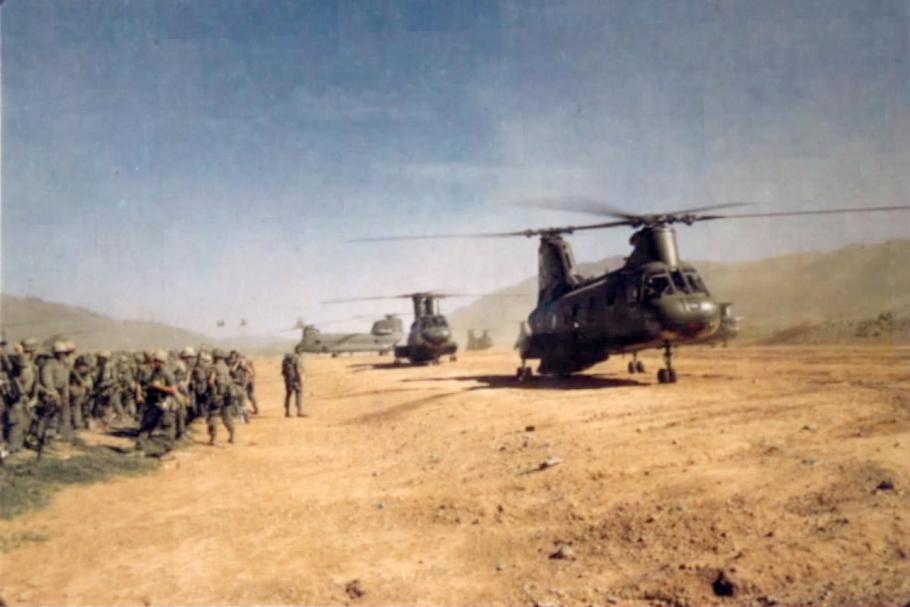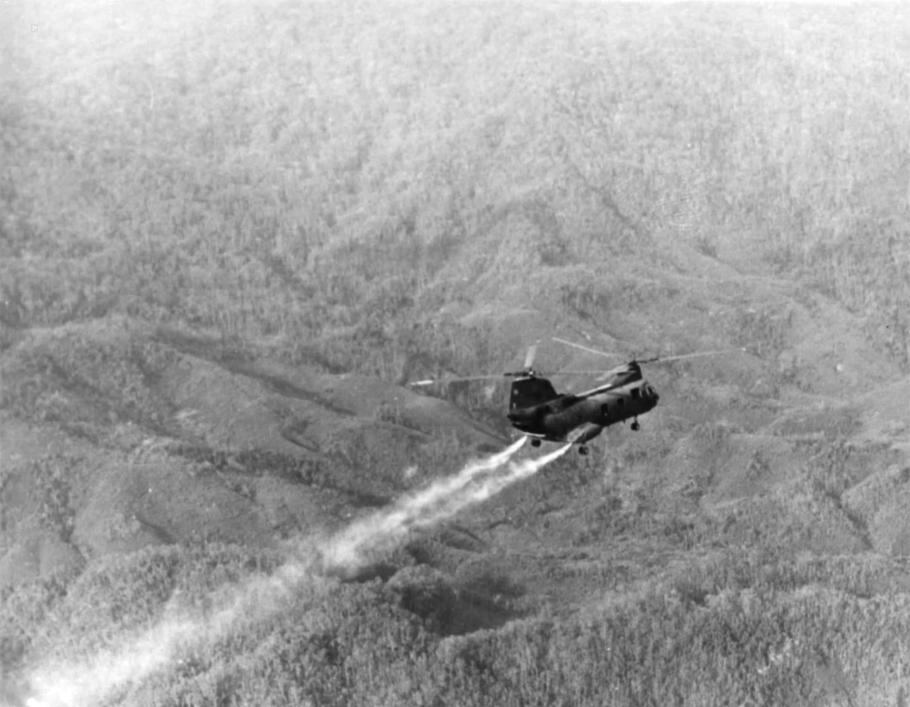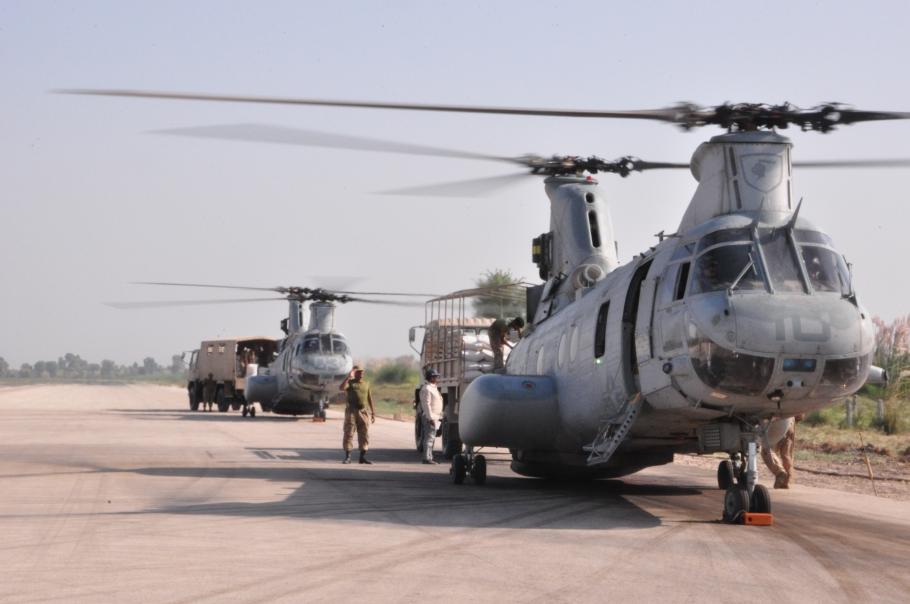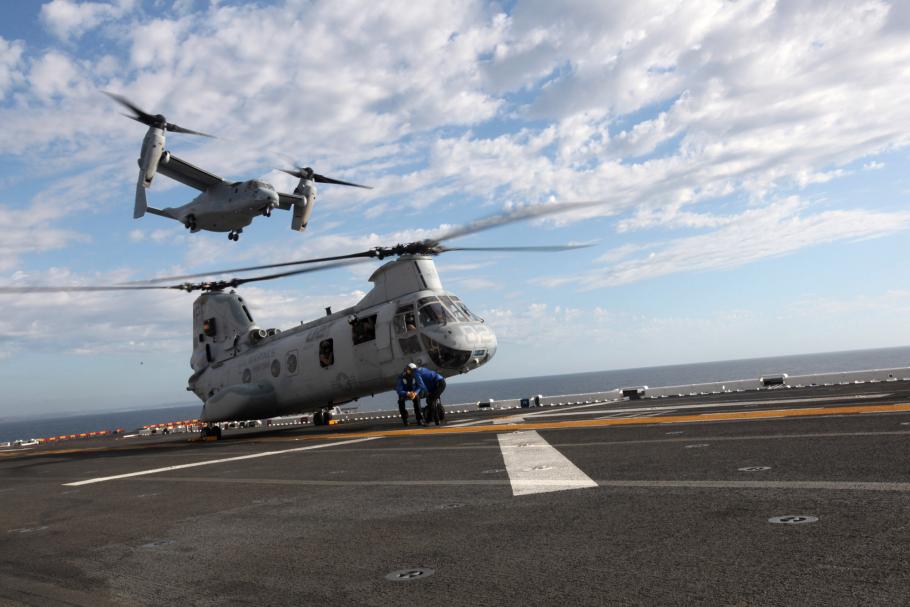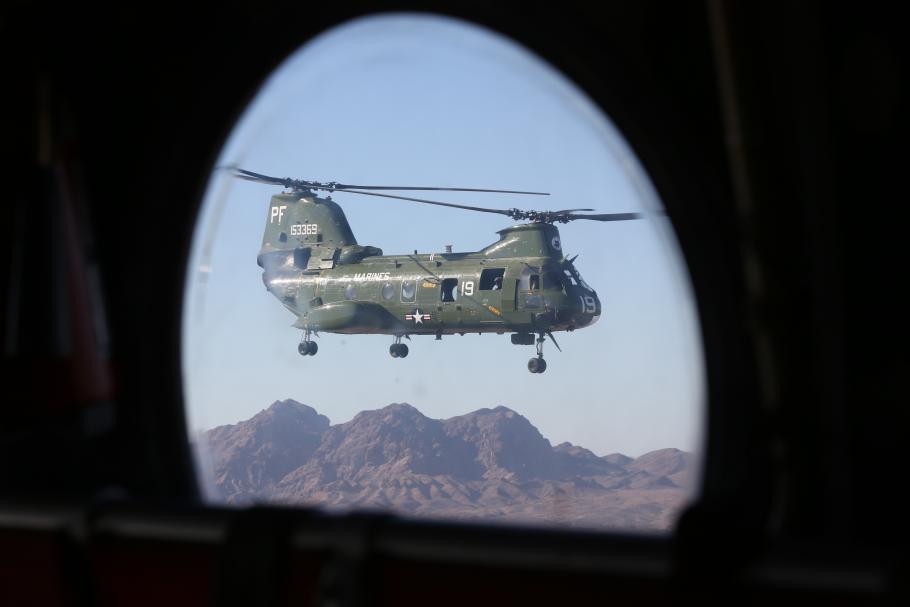In 2015, the National Air and Space Museum joined with the United States Marine Corps and the National Museum of the Marine Corps to bid adieu to one of the most important American military aircraft of the past 50 years, the Boeing CH-46 Sea Knight, or “Phrog,” as it is almost universally known among Marines. Although often overlooked next to the Vietnam-era Huey in the pantheon of helicopter fame, this aircraft may well have been at the forefront of more American military operations in peace and war than any other. The Phrog, named for its squat, amphibian-like appearance and tendency to bounce when taxiing (the origin of the “ph” is a bit more obscure), has been the unsung hero of Marine Corps operations since June 1966 when squadron HMM-265 began operations in South Vietnam.
A Boeing-Vertol CH-46E Sea Knight, or “Phrog” as it is commonly referred to, at the Norfolk Naval Air Station hangars of Marine Corps Reserve Medium Squadron HMM-774. (Navy Bureau Number 153369)
The Phrog has been the Corps’ longest serving helicopter by a wide margin and has been most useful in the remote corners of the globe. However, its origins are tied closely to the atomic bomb and superpower conflict. The 1946 atomic tests at Bikini showed that the Marines’ previous way of war—concentrating amphibious forces against defended beaches—was untenable if the enemy had nuclear weapons. Their solution was a strategy known as “vertical envelopment,” to leapfrog the defenses with helicopters and outflank the enemy. The attacking force would be weaker, but it would also be striking where the enemy wasn’t. Coincidentally, this strategy for dealing with the extremes of potential Cold War outcomes proved ideally suited to the proxy wars that occurred on the fringes of the American and Soviet spheres over emerging Communist and anti-colonial insurgencies. The Korean War validated the helicopter’s potential, but it was the British and French experiences in Indochina, Malaya, and Algeria that demonstrated just how critical helicopters were in conflicts where road networks were severely limited.
These HRP-1 “Flying Bananas” are seen performing a public demonstration at the 1949 Cleveland Air Races. This included a demonstration of the concept known as "verticle envelopment." The U.S. Marine Corps' squadron for helicopter development, HMX-1, pioneered this aerial movement which allowed personnel to bypass enemy strongpoints.
The Vertol Corporation, soon to be part of Boeing, manufactured the H-21 used by the U.S. Army and Air Force, as well as the French army, which employed them extensively in Algeria. Based on the Algerian experience, Vertol proposed a new design—the Model 107, which immediately found favor with the Army. This new design utilized turbine engines instead of a reciprocating power plant, giving it greater power in a smaller package. The proven tandem rotor configuration was ideal for accommodating both internal and external loads. By the time the first samples were under production for the Army, the Marines had committed to the replacement of its existing Sikorsky HUS fleet, known as the UH-34 from 1962. In 1961, the Marines embraced the Army version of the Model 107, which the Corps designated the HRB and would become the CH-46 the following year. The Army ultimately decided the Model 107 was too small for their needs and had it redesigned into a considerably larger version, which would soon become known as the CH-47 Chinook.
Ultimately, the Marine Corps acquired over 400 CH-46s which fully replaced the UH-34s by the late 1960s. This transition couldn’t have come sooner. The UH-34 had been a vast improvement on its predecessors when it entered service in the mid-1950s, but it struggled heavily in the hot, humid conditions of Southeast Asia, and although the cabin could carry 12 armed troops, it struggled with half that load. Provided it didn’t have to carry too much fuel, the Phrog could carry 17 fully equipped Marines.
CH-46 helicopters, and an Army CH-47 Chinook in the background, support Operation Scotland II during the Vietnam War. The helicopters are in the Demilitarized Zone on September 1968 following the aftermath of the siege of Khe Sanh.
The Phrog served admirably in support of Marine combat operations in Vietnam, including some very high profile operations such as the resupply of the besieged Khe Sanh garrison and the evacuation of the U.S. embassy in Saigon as it fell in 1975. However, CH-46 crews suffered heavily. A series of in-flight break ups led to a panicked search for technical solutions. As one of the larger helicopters in service, it was also a juicy target for the enemy—one that had limited defensive firepower and a number of vulnerable systems. Over a third of all Marine CH-46s were lost in Vietnam, with 109 brought down by hostile fire (40% of the Marine helicopters lost to enemy action) and another 50 destroyed by accidents and other causes.
A CH-46, "Phrog," jettisons fuel during an emergency extraction west of Da Nang, Vietname, in June 1970.
After Vietnam, the CH-46 continued to serve with the changing tides of American military involvement. Even in peacetime, the Phrog frequently was tasked with evacuations from embassies during periods of unrest and civil war abroad. By the 1970s, the proven Phrog was showing its age and the Marine Corps began looking at new technologies. Ultimately, Bell-Boeing MV-22 Osprey tilt rotor emerged as the solution to the Phrog’s Achilles heel—range. However, while the Osprey underwent an agonizingly slow and plagued development, the CH-46 suddenly began to shoulder a greatly increased burden of operations in the turbulent geopolitical environment as the Cold War drew to a close. Less than 300 airframes had to support demanding trials by fire and the elements in Grenada, Beirut, Operation Desert Storm, Somalia, Haiti, Bosnia, Iraq, and Afghanistan. One of the more enduring accomplishments of the Phrog that often gets lost with the focus on combat operations, was its starring role in humanitarian and disaster relief efforts. On five continents the Phrog helped deliver countless meals and water to survivors of earthquakes, famines, hurricanes, typhoons, floods, and civil war.
During severe flooding, two U.S. Marine Corps CH-46 Sea Knights are loaded with bags of flour donated by the World Food Program before flying to an aid distribution site on October 21, 2010 near Pano Aqil Cantonment, Pakistan.
Now, as the final CH-46 squadron, HMM-774, begins its conversion to the MV-22, the final examples of this helicopter are finishing out their storied careers of five decades. As a fitting tribute to the legacy of this aerial workhorse, the Marine Corps has set aside one particular Phrog to represent and carry the flag for this type. The chosen Phrog, Navy Bureau Number 153369, is a worthy candidate for the honor. One of its pilots, 1st Lt. Joseph Donovan was awarded a Navy Cross for a rescue under fire in Vietnam during April 1969. Unfortunately, like nearly all Phrogs, the aircraft records provide an inadequate history of the everyday heroism exhibited by the aircrews and Marines, like Lt. Donovan, that flew on these helicopters. 153369’s recent history is no less distinguished than its Vietnam history. It served in both Iraq and Afghanistan during some of the most intense periods of combat. Between February and September of 2004, it operated with squadron HMM-266 in the Oruzgan province in central Afghanistan. It also operated in Iraq with squadrons HMM-161, HMM-268, and HMM-364 over a three-year period, starting during the height of the “surge.”
The more advanced rotorcraft Bell-Boeing MV-22 Osprey is seen flying above its predecessor the CH-46. The MV-22 will take the place of the CH-46 following its retirement in July 2015. Both types are seen preparing for San Francisco Fleet Week in October 2011.
On August 1, 2015, helicopter 153369 will be added to the collection of the National Museum of the Marine Corps. At the moment, their Quantico, Virginia location is unable to accommodate the airframe. While the Marine Corps Museum creates space, the National Air and Space Museum will display the helicopter at the Steven F. Udvar-Hazy Center in Chantilly, Virginia as a long-term loan. The aircraft is wearing a high-gloss version of its Vietnam paint scheme as a tribute to the type’s original trial by fire and for its central place in Marine operations in Southeast Asia during the Vietnam War.
This CH-46 Sea Knight (Bureau Number 153369) will be the flag bearer for the helicopters retirement in July 2015. It is seen here in October 2014 in an updated, yet retro Vietnam-era paint scheme applied by the HMM-364 “Purple Foxes,” who operated this aircraft extensively during the Vietnam War.
The delivery flight and public ceremony for 153369’s retirement at the Steven F. Udvar-Hazy Center on Saturday, August 1 at noon, was the last public showing of an airworthy CH-46 and is the Marine Corps’ formal sunset ceremony for the type. To celebrate the Phrogs’ five decades of service and the complete transition of the Marine’s medium lift capability from CH-46 to MV-22, the event was open to the public. Visitors had the opportunity to walk through the 153369, as well as an MV-22 that supports HMX-1, best known for its role in supporting transport of the President. Have you had experience with the CH-46 Phrog? We’d love to hear your story. Leave us a comment to share or simply say goodbye to this venerable aircraft.

